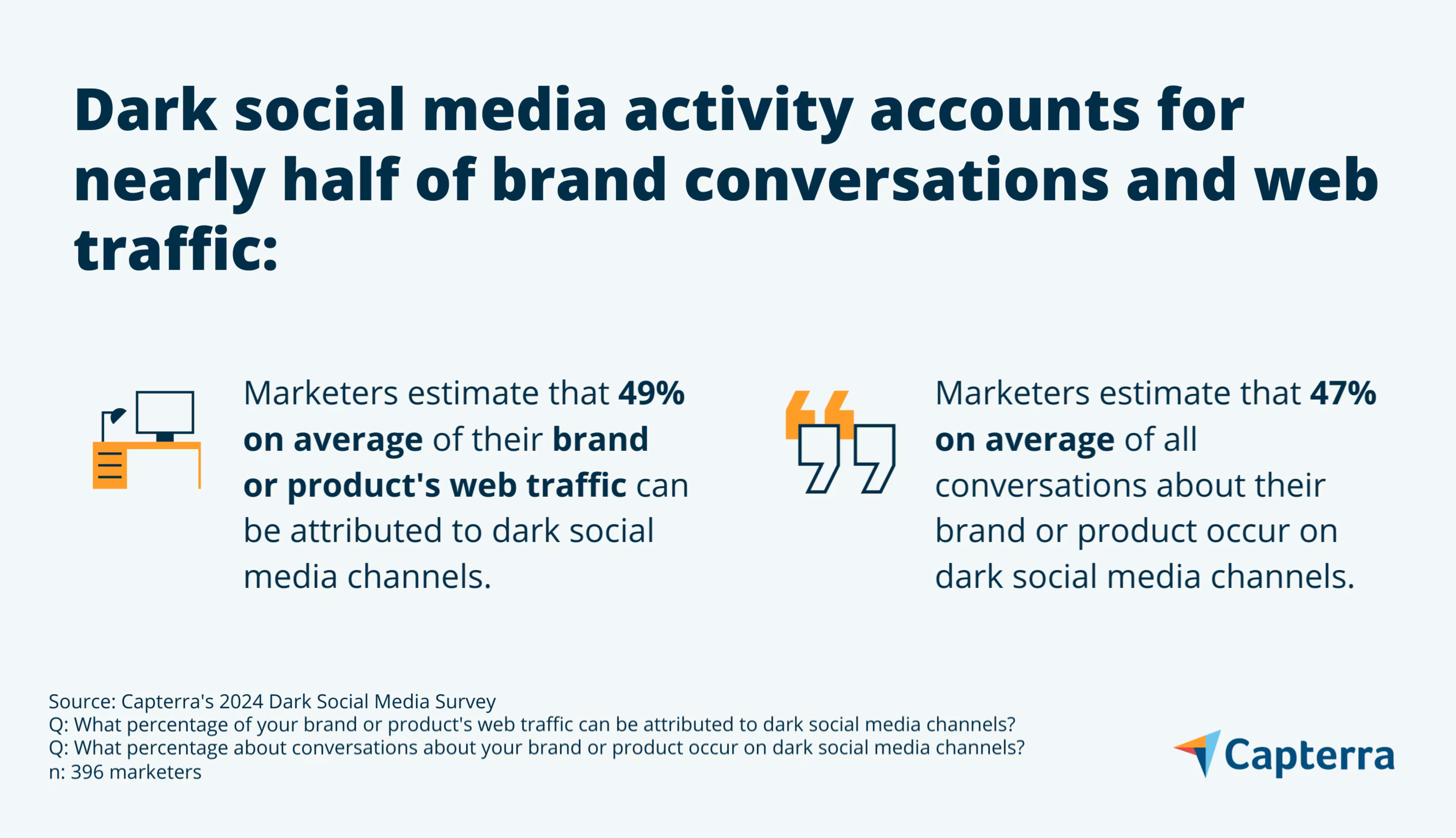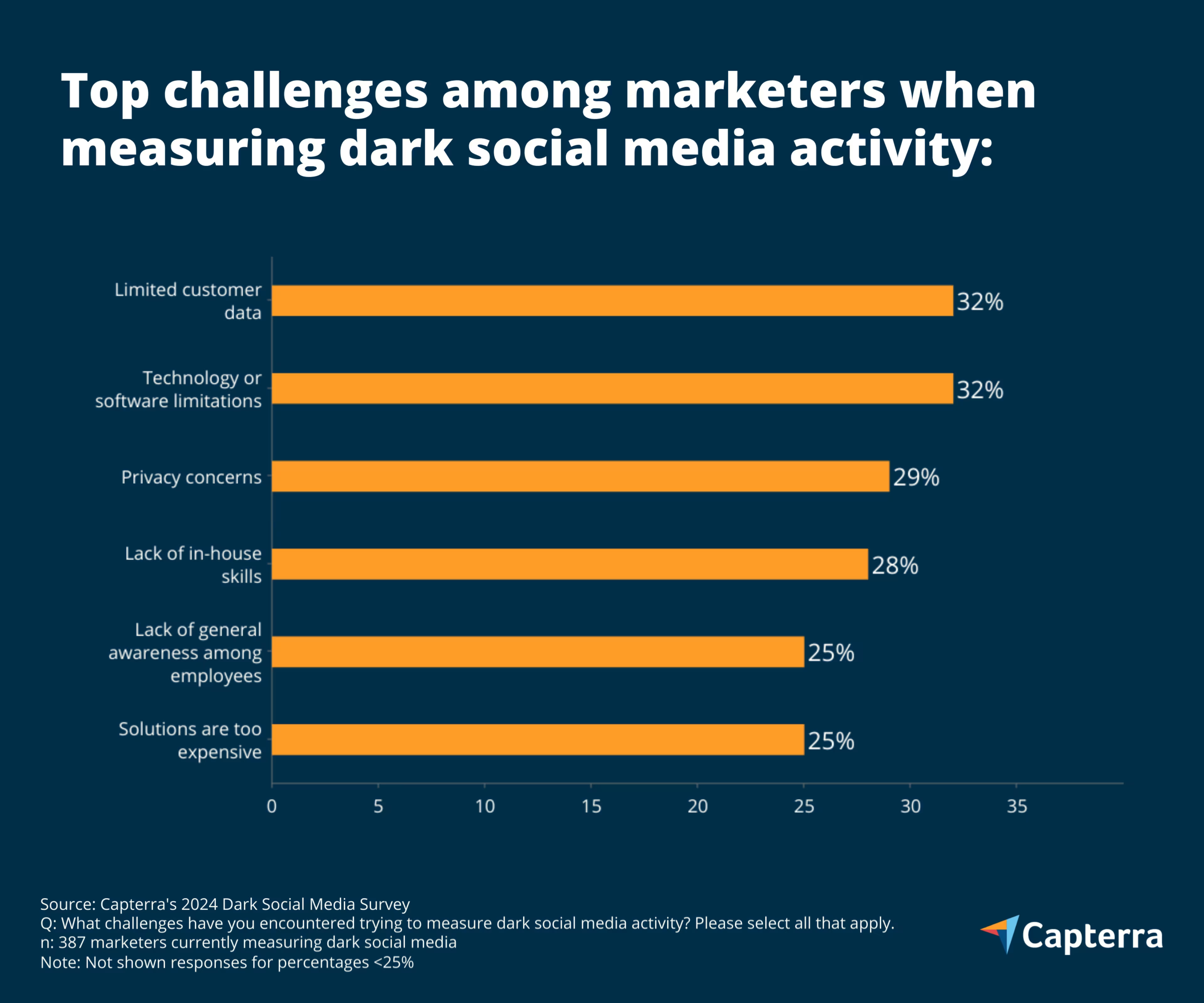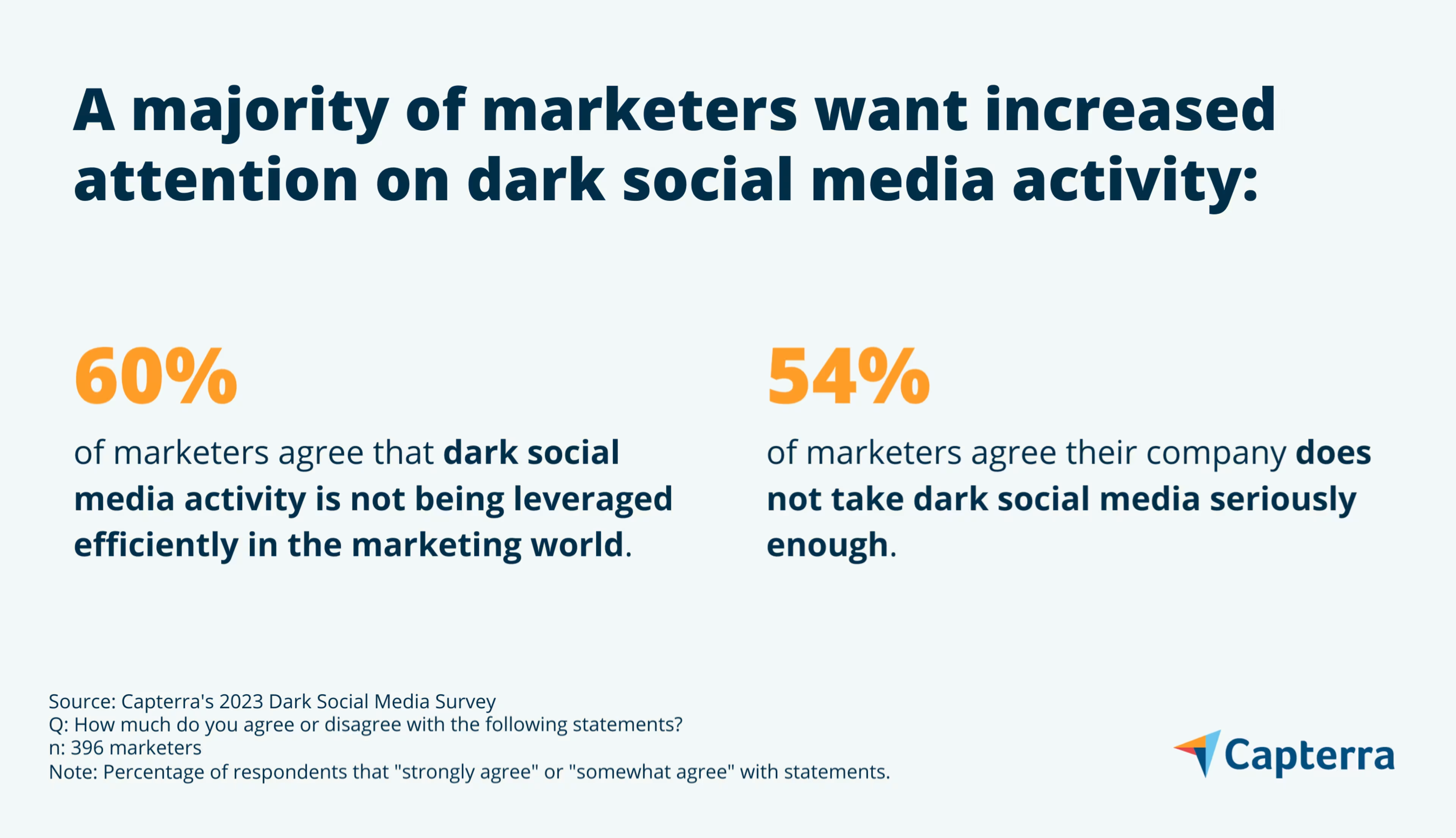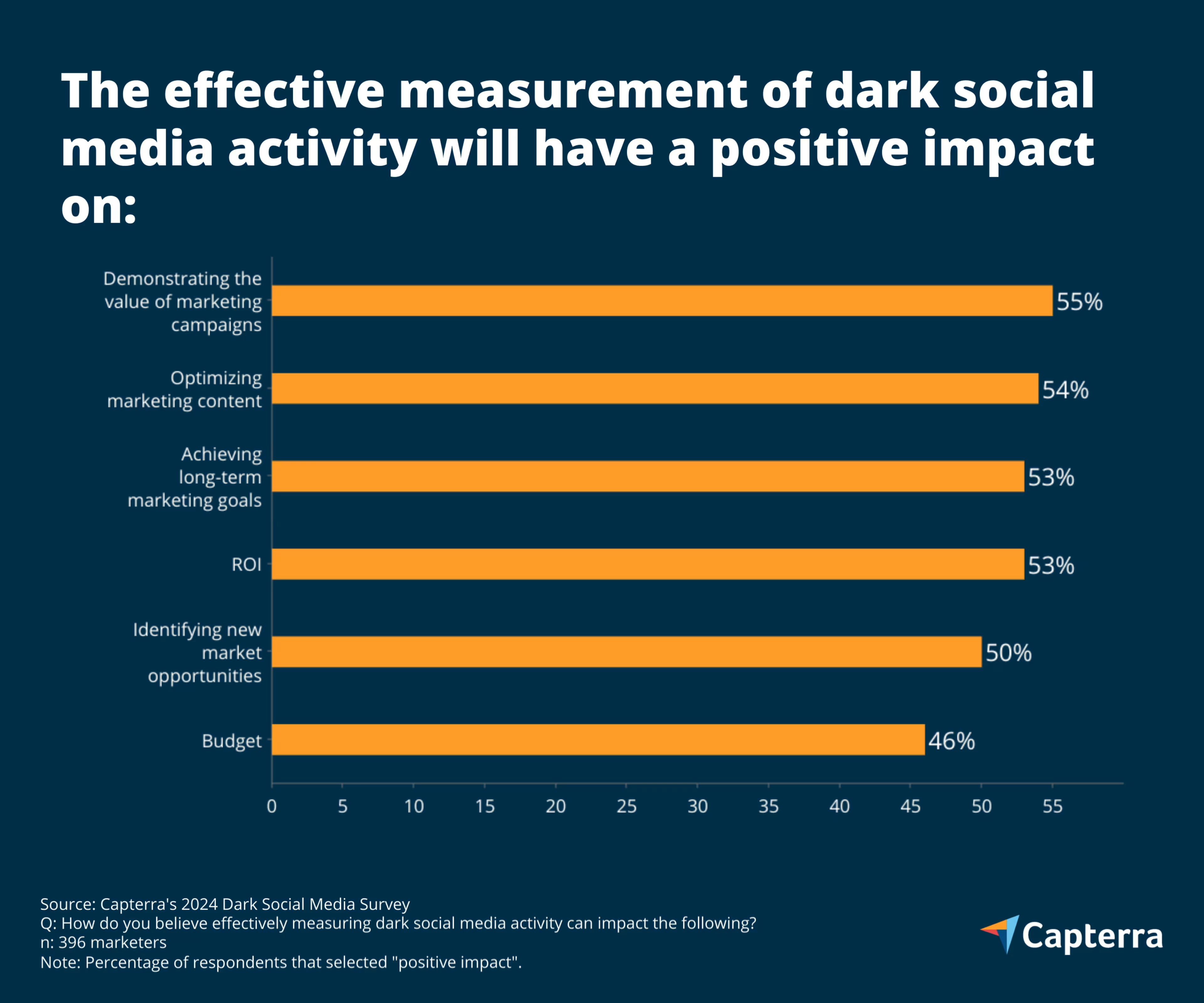Tapping into dark social helps marketers demonstrate the value of their campaigns.
In an era where privacy-minded consumers are seeking refuge in smaller, more private spaces online, data tracking and attribution have become increasingly difficult for marketers. And as a marketer, you could be missing out on important brand conversations and unable to track the outbound sharing of links when consumers go “dark.”
What is dark social media?
The term “dark social media” refers to the private sharing of content through channels such as messaging, emails, apps, and private spaces where tracking is notoriously challenging. Unlike sharing on public social media platforms, such as Facebook or X where interactions are visible to all, dark social media activity evades marketing analytics tools or programs.
According to Capterra’s 2023 Dark Social Media Survey, nearly one-third of marketers (32%) say that the limited or complete lack of ability to track customer conversations in private channels is one of the top challenges hindering their ability to understand customer behavior at their company. A majority (81%) also believe that consumer conversations that happen in private spaces will only continue to grow over the next year.*
Our research reveals how marketers are tracking dark social media activity and provides guidance for optimizing campaigns. Find out why it’s essential to have the right tools and knowledge to amplify dark social media sharing and even include it in your ongoing marketing practices.
/ Key findings
Dark social media activity is estimated to be a large proportion of web traffic and brand conversations: Marketers say that on average nearly half (49%) of their brand or product’s web traffic can be attributed to dark social media channels.
The measurement and attribution of dark social media is difficult: One-third of marketers that are currently measuring dark social activity are only somewhat confident in the accuracy of their company’s measurement methods.
Marketers believe that the effective measurement of dark social media can yield positive outcomes: 55% believe that effectively measuring dark social media would have a positive impact on demonstrating the value of marketing campaigns.
Marketers could be doing more to leverage the power of dark social media: 60% of marketers believe that dark social media activity is not being leveraged efficiently in the marketing world.
Why dark social media should be on the radar of your marketing team
Nearly three in four marketers (73%) say they are extremely or very familiar with the term “dark social media.” Even if they haven’t heard of the term specifically, they are likely all too acquainted with the types of online activity that evade marketing attribution or analytics.
Many online behaviors can fall into the realm of dark social media sharing. For example, something as simple as pasting a link (without a tracking code or from an unsecured webpage) into a text, direct message, or email means that you can’t tell where a click originated. Consequently, your analytics will indicate that the user manually typed out the URL, although in reality they received it through dark social media.
Some additional examples of dark social media activity include the following:
Private messages inside native apps such as Facebook, Messenger, Instagram, etc.
Private messaging apps such as WhatsApp, Discord, Slack, etc.
Private social social media channels such as closed groups on Facebook, Reddit, or content shared with only friends and followers.
Our survey asked marketers to provide an estimate for how many brand conversations are taking place via dark social media channels and how these conversations impact their web traffic:

That’s a lot of potential impact on your analytics and traffic—and why tracking dark social is so critical. In fact, 62% of marketers believe that their brand or product’s web traffic from dark social media channels will increase over the next six months.
We have a few theories why dark social media sharing may only continue to grow:
Changing attitudes about privacy: With heightened awareness about data privacy, consumers are becoming more cautious about what and where they share online. Capterra data supports this, with four in five consumers (82%) saying they have stopped doing business with a company because they disapprove of their data practices. Another 83% of consumers say they would pay more for a private version of a product or service.**
Continued usage of social media: According to Pew Research, roughly seven in 10 U.S. adults say they use social media (which has remained relatively stable over the last few years).[1] According to our survey, 68% of marketers believe the highest occurrence of dark social media conversations or sharing takes place in private social media pages or groups, followed by private messages inside native apps like Facebook Messenger, Instagram, etc. (62%). Among them, 84% believe Facebook is where the highest occurrence of dark social media conversations are taking place followed by 76% on Instagram.
iOS updates: Beginning in 2021, Apple introduced iOS14, which included App Tracking Transparency (ATT) features. With it, users could easily block apps from receiving a unique Identifier for Advertisers (IDFA) embedded in their iPhone devices.[2] Apple continues to release privacy-focused features that allow consumers the option to opt-out of tracking across apps, hindering marketers’ ability to collect data on their audiences.
The prevalence of peer recommendations: Content shared though dark social media often comes from trusted friends or family. Many consumers rely on these recommendations when making purchase decisions because they come with a higher level of authenticity and trust. The sharing of product links, reviews, or deals from trusted sources all contribute to the rise of dark social media.
Data and technology limitations hinder dark social media measurement
Because it’s impossible to 100% accurately track and measure dark social media activity, marketers may face an uphill battle. However, awareness surrounding the most common measurement hurdles can help you tackle the challenge:

Why you need a data strategy: These hurdles point to the need for a long-term data strategy that outlines how your company plans to collect, store, and use customer data. This can guide technology investments and gradually improve your data capabilities. Additionally, your company should be regularly cleaning and updating existing customer data to gain a more accurate view.
Are you looking for data collection or management software? Browse our list of top data collection and data management software.
Another limitation to consider is the prevailing lack of marketer confidence in accurately measuring dark social media activity. This is likely due to the limited control they have over how content is shared in dark spaces.
Our survey results find that among respondents that are currently tracking, one-third say they are only somewhat confident in their company’s current methods for measurement. Furthermore, 55% of survey respondents agree that the attribution of dark social media will always be imperfect.
That’s not to say that marketers want to give up. Rather, they’d prefer more action from their companies when it comes to dark social media.

How to engage marketing leaders and dispel skepticism: Emphasize how dark social media strategies align with broader business objectives, such as gaining market share and boosting organic engagement. Furthermore, introduce marketing leaders to tracking methods (we’ll go over a few popular methods below) and technologies that enable better measurement of dark social media activity.
Marketers believe the effective measurement of dark social media activity yields positive outcomes
While it may seem burdensome, effectively measuring dark social media activity presents a unique opportunity to demonstrate the importance of marketing initiatives.
You don’t want to miss out on instances where valuable customer referrals, interactions, or conversions occurred in dark social media channels but were not attributed to marketing campaigns.

Our research dives into the top methods and tools companies are currently using to measure dark social media activity:
Google Analytics: Forty-five percent of survey respondents say they have refined Google Analytics in order to measure dark social media activity. Essentially, you will need to separate out direct traffic to determine where your audience is coming from. Excluding traffic to the homepage, landing page, or other easy-to-remember URLs can act as a useful starting point. Doing this will exclude all the pages that site visitors can realistically reach directly and leave you with pages that have a complex URL structure.
UTM parameters: These are text codes you add to URLs to help track the performance of a webpage or marketing campaign from its origination point. Forty-two percent of survey respondents say they utilize these parameters to measure dark social media activity. Links with UTM codes will tell your analytics software what visits are associated with a campaign.
Forms: Another useful method for measuring dark social media is through the use of forms on your website. For example, 42% of survey respondents say they have added a “How did you hear about us?” form on their website or app to learn how customers discovered their business. Forms like this give you the opportunity to ask users directly how they discovered your content.
Referral programs: Relying on influencer marketing can also help you track social media traffic. Our survey found that 40% of marketers currently use this method to measure dark social media activity. A common example of this would be an influencer providing a discount if a user purchases using a trackable code or link for the purposes of monitoring.
Embrace dark social media and optimize content for private sharing
Peer recommendations play a key role in purchase-making decisions and in today’s digital era, dark social media channels are a central outlet for sharing brand or product information. That’s why in addition to incorporating dark social media estimations into your analytics practices, you should be optimizing content for private sharing.
Marketers are currently attempting this through creating content that encourages sharing or conversation (57%), as well as providing direct links through social media apps (50%), and by tailoring content to specific audiences (48%).
Dark social media isn’t to be ignored. If you disregard it, you could be missing out on valuable insights into your most effective campaigns, channels, or content which can be used to optimize your marketing strategy and spend.
If you liked this report, check out some of out other research on the latest marketing technology trends:

